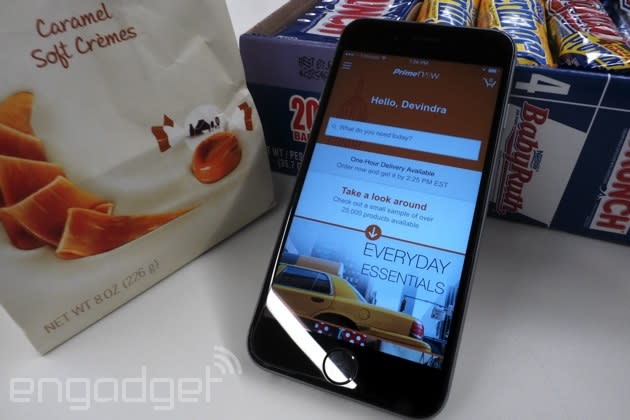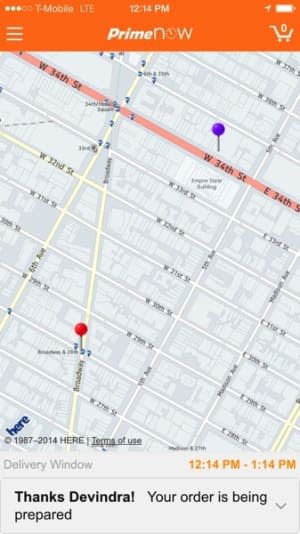Amazon Prime Now brought me candy in 23 minutes

Amazon's new one-hour delivery service, Prime Now, works so well it might just inspire entirely new levels of laziness in all of us. After all, why bother going to the store when you just need to shell out $7.99 to get anything brought to your door in an hour? But as anyone who's made Seamless or GrubHub food deliveries an essential part of their diet can tell you, this sort of instant gratification can be dangerously addictive. And eventually, you might end up having no reason to leave your house at all. As the Amazon courier handed me a bag full of candy I couldn't help thinking this is how Wall-E's dystopian future begins -- a world we're all infantilized to the point of not being able to walk, or do pretty much anything, on our own.
But perhaps I'm stretching. The important thing is that Amazon Prime Now actually works! At this point, though, it's only available in Manhattan's 10001 zip code, which mostly covers the Chelsea neighborhood. (An Amazon rep tells me more service areas are coming later today.) And you also have to subscribe to the company's $99-a-year premium Prime service to use it. Amazon's tested several methods for speedy deliveries -- most recently with taxi deliveries in San Francisco and Los Angeles -- but Prime Now is the first time it's actually launched such a service. And it's not alone: Google's Shopping Express also lets retail stores ship you items within the same day.
After downloading the Prime Now app, I hoofed it to one of my favorite sandwich shops (No. 7 Sub, if you're curious) within its service area. The app highlights a few categories of products ideal for zippy delivery like "Everyday Essentials" and "Travel Basics," but I was already dead set on bringing some candy back to the office. After selecting a 20-pack of full-sized candy bars and a small bag of Lancaster caramel cremes, I chose to have my order delivered within an hour for a $7.99 fee (perhaps even more dangerous, two-hour deliveries and beyond are free). The app also suggested I tip my carrier $5, but you can tweak that as you see fit. My total for this test: $30.43 for $17 worth of candy.

After placing my order at 12:14pm the Prime Now app opened up a map that showed me where exactly my delivery was coming from. As luck would have it, the Amazon distribution center was only a few blocks away. At 12:27pm I received a notification that my order was out for delivery by a courier named Richard, and I watched in real time as he got closer to my location. He ended up reaching me at 12:35pm, and after a quick scan and short chat, the candy was mine. Richard wore a large Amazon coat and carried a bright tote bag, making it easy to find him in the crowd. He mentioned that he only started at Amazon two weeks ago, and since the distribution center was so close he was able to walk over with my order.
Overall, using Prime Now wasn't any different than making a typical Amazon order -- other than the additional fees and vastly faster delivery times. I could see myself using it quite a bit if I lived or worked within one of its service areas (and felt particularly misanthropic). But I'm also a Prime member already -- if you're not, you have to factor in that $99 annual fee to use Prime Now.
Given eBay's flameout with its same-day delivery apps, I also understand why Amazon chose to start its service in a relatively small area. But as amazing as one-hour deliveries are, it's likely not something Amazon will be able to offer outside of densely packed urban areas (even Brooklyn may be a stretch). It relies on being close to major distribution centers, which severely limits just how far those speedy deliveries can go. Most cities and suburbs may just have to make do with same-day deliveries.
But back to that Wall-E future. Companies like Seamless, Postmates, and yes even Uber, offer services that dramatically make our lives easier by taking care of menial tasks for us. And they're only going to get more tempting as they get cheaper and do more for us. I'm just worried about the point where technology starts doing more than the grunt work for us and starts living for us instead. Or maybe I'm just a guy who doesn't mind the stroll to the corner store.




